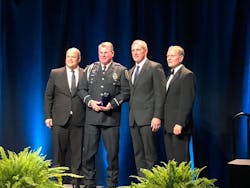This October marked the 125th International Association of Chiefs of Police (IACP) Annual Conference held at the Orange County Convention Center in Orlando, Fla., Oct. 6 to 9. The event kicked off with opening remarks from IACP outgoing president, Chief Louis Dekmar of the LaGrange Police Department (Ga.). “The reason for IACP’s success is simple,” he noted in his opening speech. “We are all facing similar challenges, similar needs and a similar desire to be more effective within our communities while recognizing the universal obligation to increase law enforcement professionalism.” Dekmar was replaced as IACP president by Paul Cell, chief of police at the Montclair State University Police Department in New Jersey. At the center of the conference was the vast number of educational sessions and the exhibit hall—including technological innovations—as well as a visit from President Trump.
Technology abounds
The leaders of the first IACP in 1893 would certainly be blown away by the changes in policing that have happened in the last 125 years, as well as the technology options available today. At the show, Axon introduced several new products including its TASER 7 conducted energy weapon (CEW). The TASER 7 includes improvements such as adaptive cross connect and an enhanced spiral probe design, with nearly double the kinetic energy to compress loose and hanging clothing.Plus, it’s integrated with Axon’s digital data management solution, Axon Evidence. In addition to its new CEW, Axon announced a redesigned Axon Academy and TASER 7 weapon reality-based training program to aid LEOs in de-escalation. Axon Academy will now include empathy training, available for TASER 7 customers. The company released its Axon Body 3 body camera with LTE—wirelessly connected via FirstNet—featuring gunshot detection, with automatic alerts to command staff and live streaming. It is reportedly expected to ship to U.S. customers in the summer of 2019.
Video management software continues to be a topic of interest as agencies integrate video equipment from body worn cameras and in-car video. There is a verbalized need for software that integrates multiple video sources with metadata and syncs it all on a timestamp.
On the show floor, Panasonic released its Unified Digital Evidence software that gathers and stores digital evidence from the Arbitrator in-car and body-worn camera platforms, as well as fixed surveillance sources and a variety of digital media devices.
Many companies were showcasing their technology that, in one way or another, connects to the patrol car. Utility Inc., makers of BodyWorn, announced collaboration with Sony Imaging Products & Solutions Inc. to develop Smart Patrolling, an in-car camera video system with artificial intelligence. It achieves license plate capture through an in-car video system, essentially freeing officers from keying in license plate numbers.
In virtual simulation training technology, Meggitt released its new FATS 180LE simulator for smaller spaces—it consists of three borderless 150” by 84” screens with a 16:9 aspect ratio. “The FATS 180LE represents a balance between our 300-degree FATS 300LE and flat-screen FATS 100LE,” said Matt Cunningham, director, virtual systems sales, Meggitt Training Systems, in a release.
Threat assessment and pre-incident planning is an ever-growing need in law enforcement. FARO’s new ScanPlan handheld 2D mapping solution captures floor plans in real time. Users can control the ScanPlan with a smartphone application that shows the floor plan map as it is being captured.
One upcoming piece of technology that had attendees excited was Select Engineering Services LLC’s Automatic Injury Detection (AID) Vest. The AID panels are used in addition to existing body armor. The AID detects attacks on officers and sends GPS location, injuries, heart rate and blood type over radio and text messages to the entire agency. Read more about how the Rio Grande City Police Department (Texas) became one of the first departments in the nation to test these new Bluetooth-connected sensor panels at Officer.com/21013061.
Although continuing education and distance learning colleges have exhibited at IACP in the past, this year some were offering pre-approved credit counts for things like military basic training, military specialty school, police academy, etc. If an officer can produce a certificate for the number of hours spent on the given topic, they can receive pre-approved credits for it. There was also a focus on flexible schedule online training, with the awareness that many officers taking college classes are doing homework and online course work on the midnight shift.
Presidential address
Beyond education sessions and the exhibit hall, attendees were drawn to a visit and speech by President Trump on Monday, Oct. 8.
Governor Rick Scott preceded President Trump, noting in his opening remarks that Florida is at a 47 year low in crime rate, “…thanks to the hard work of Florida’s law enforcement. As police chiefs, you have the privilege to be in command of fine men and women who every day put their lives on the line in service to our communities and to show their heroism in the face of danger. There has never been a more critical time to have leaders like each of you protecting our families. As we take this opportunity to recognize your service, we also recognize the incredible bravery of our officers in the face of unimaginable danger.” The state made it a top priority to honor the fallen law enforcement by taking care of their families. In 2016, state law was changed so that families of fallen officers receive 100 percent of their loved ones’ monthly salary for life. “This was the right thing to do,” Scott said.
President Trump spoke on numerous topics, one of which was calling for a return to the stop-and-frisk method, saying, “It’s got to be properly applied, but stop-and-frisk works.” Trump additionally called for the death penalty for criminals who kill law enforcement officers, noting, “We believe that criminals who kill our police officers should immediately, with trial—but rapidly as possible; not 15 years later, 20 years later—get the death penalty.”
He also announced another $42.4 million for the High Intensity Drug Trafficking Areas program to attack the U.S. opioid epidemic.
The president ended his speech with gratitude towards all law enforcement. “America’s police officers have earned the everlasting gratitude of our nation. In moments of danger and despair, you are the reason we never lose hope—because there are men and women in uniform who face down evil and stand for all that’s good and just and decent and right.”
The 2019 IACP conference will take place next Oct. 26 to 29 in Chicago, Ill.

Adrienne Zimmer | Editor
Adrienne Zimmer was the Editor of Law Enforcement Technology magazine, a monthly business-to-business publication that covers technology trends and best practices for public safety managers from 2017 to 2019. LET is part of Officer Media Group, which also publishes Law Enforcement Product News and Officer.com. Adrienne has been in publishing since 2013.




